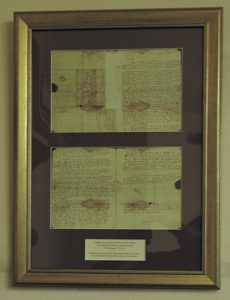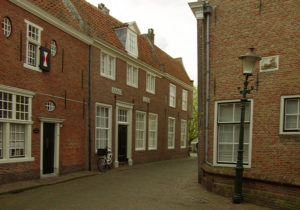Epworth Old Rectory is a lovely Queen Anne brick and stone building surrounded by a tall brick wall on the edge of Epworth. It is a popular tourist attraction, particularly for Methodists. There is plenty of Wesley memorabilia for them to enjoy.
Samuel Wesley was rector at St Andrew’s Church for forty years and John and Charles Wesley were born here. Their first house built of wood and thatch, burnt down in 1709. John had to be rescued from a bedroom window. Samuel rebuilt the house at a cost of £400 which left him permanently in debt. It remained the rectory until 1957 by which time it was in a very poor condition. A new rectory was built and the Methodist Church bought the building. The Old Rectory became a guest house, although it did welcome visitors. In 2002 the decision was taken to restore the building as a museum and to return it to what it might have looked like when Samuel and Susanna Wesley and their ten children lived there.
Most of the Wesley furniture was sold after Samuel’s death to pay for his debts. Some furniture and artefacts belonging to the Wesleys have been returned. The rest of the furniture is either from the period or modern reproductions.
Visits are by guided tour only and when I visited seem to be ‘on demand’. It was a wet October day and I was the only visitor. The guide was informative and entertaining with a wide knowledge. She answered all my questions patiently and gave me plenty of time to take pictures. Not being a Methodist, I still found plenty to interest me.
The Tour enters by the front door into the ENTRANCE HALL. The fireplace has been opened up recently and would have had cupboards on either side. There is a strong smell of woodsmoke. It is thought the entrance hall may have been used as a dining room and it has a large reproduction table. On the wall is a lovely carved oak dresser reputed to have belonged to the Wesleys. This was sold to the Red Lion Pub in the Market Place and later sold to someone in Cheshire before being returned here. On it is a bust of John Wesley and a white marble statue wearing a cassock and preaching bands.
To the right of the entrance hall, up a slight step is the PARLOUR. This would have been used for entertaining guests after dinner, but is now furnished as a dining room. The fireplace is the one from the entrance hall, removed when the brick fireplace was uncovered. Above the fireplace are portraits of Samuel and Susanna. In the corner is a small gaming table thought to belong to John along with his chair.
The top of the long clock also belonged to John and would have been wall mounted. The case was made by a local farmer and isn’t of the same quality. The clock only has one hand recording the hours.
The tour now continues up the main STAIRCASE. It is a classic Queen Anne staircase with very shallow treads, designed so ladies to ascend without having to raise their skirts and show their ankles. On the wall are two prints showing the Rectory fire with the young John being rescued from a burning window by the villagers while the family huddle together and look on. There is another print showing John preaching to a crowd of 30,000 in a quarry in Cornwall. This acted as a natural amphitheatre so everyone could here.
At the end of the corridor on the south west side of the house is what was the BEST CHAMBER. This may originally have been used by guests as it is thought Samuel and Susanna slept at the other end of the house. Now it is furnished as their bedroom. The chest and screen are typical examples of bedroom furniture of the period. On display is an example of a dress similar to what Susanna might have worn.
The bed is described as a ‘stump bed’ with a carved headboard. At the base are the holes through which the ropes supporting the mattress could be tightened to give a good night’s sleep. Hence the expression “sleep tight”. The quilt belonged to the Bolton family of Witney. John often stayed with them. It is a beautiful example of C18th quilting.
In a corner of the room is a prayer chair. The top is hinged and can be turned to make a kneeling desk. Below the seat is a drawer which could be used to keep the bible safe. Susanna retired to her room for an hour’s prayer ever day.
Next door, at the top of the stairs is SAMUEL WESLEY’S STUDY. The desk belonged to a contemporary and supporter of John. The bookcase is a modern copy. Above the fireplace is the letter appointing Samuel as rector of Epworth.
Samuel was permanently in debt and eked out his income by writing. There is a display of some of his works. This includes a life of Christ written in verse and one volume of a fourteen volume opus on Job, all written in Latin.
At the far end of the corridor is the NURSERY where the children lived and slept until they were five. They then started having lessons with Susanna. This contains a small wooden crib and Susanna’s sewing box on a wooden chest.
Samuel and Susanna’s bedroom was probably at this end of the house between the study and nursery. The room is now has an EXHIBITION about John Wesley. The wax model was made for display in the Millennium Dome and is based on a portrait of the time.
There are portraits of both John and Charles and also prints on the walls. These include one of John preaching from his father’s grave outside the church. John had been banned from preaching in the church although he remained a Church of England clergyman until his death in 1791. He wanted to reform the Church of England and never intended to start a new movement. Methodism only began after his death. There is a scene of his death bed where he is surrounded by all his friend declaring “The best of all is – God is with us”.
The display cases have a changing programme of exhibits. When I visited there was a display of loving cups and ‘shock’ pots. These have a frog or lizard on the base and the shock of seeing this as the drinker finished his drink was supposed to stop him wanting to drink.
There is also an old leather shoe which was recently discovered in a hidden cupboard in the kitchen. There was a tradition of placing an old shoe in the wall of a newly built house to protect the house and this may be one of Samuel’s shoes.
A steep flight of stairs, still with exposed timber framing on one wall, lead up to the ATTIC. This was probably used as a storage area for grain and flax was dried here. The room is referred to as ‘Jeffrey’s Chamber’. The Rectory suffered from a poltergeist for a few weeks in December 1716 and into January. Samuel and Susanna thought the girls were responsible but they denied this. They named the poltergeist after an itinerant worker who had worked for the family but died before the hauntings began. They stopped as quickly as they had begun.
There are display cupboards with John Wesley memorabilia, mainly plates, figures and busts. One large display cupboard contains the Doughty Collection and contains over a hundred items. He had a life long interest in John Wesley and was President of the Wesley Historical Society. His collection was given to the Old Rectory by his widow on his death in 1966.
The very steep back stairs used by the servants lead into what was originally the WASH HOUSE or back kitchen. It would have contained a copper and sink. This now contains a lovely old wooden dresser with a display of pewter. Next to it and beneath what was probably Samuel and Susanna’s bedroom is the FRONT KITCHEN. The huge open fireplace has been exposed. The alcoves on either side would originally have ben cupboards. The small hole above the far alcove is where the shoe was found. The exposed charred beams above the fireplace were reused pieces of wood from the burnt down rectory.
In the centre of the room is the large kitchen table, now set up for children’s activities. Under the window is a small table which was used by the Wesley children until they had learnt their table manners and were allowed to eat with the grown ups.
This is where Susanna held her religious meetings for servants and locals. These became very popular and large numbers attended. The curate wrote to Samuel who was in London at the time, to complain about them and that Susanna was stealing his congregation. A copy of Susanna’s reply to Samuel, who had no intention of stopping the meetings, can be seen on the wall.
It was raining steadily the day I visited so I didn’t explore the garden and grounds with its recently planted physic garden, rare breed sheep, chickens and beehives.
In some way, there isn’t a lot to see in the Old Rectory. It is the Wesley connection and all the stories about the Wesley family which draws in the visitors. The guide was interesting and knowledgeable. I was the only visitor and I found it an enjoyable visit.
ACCESSIBILITY
The grounds, shop and ground floor are accessible for wheelchairs. The first floor and attic is not, although there is a reduced charge for those unable to access these parts of the house. Parking can be arranged close to the house and guide dogs are welcome. There is a disabled toilet.
“Website”:http://www.epwortholdrectory.org.uk/









